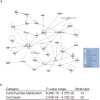Proteomic analysis of lymphoblastoid cells derived from monozygotic twins discordant for bipolar disorder: a preliminary study
- PMID: 23408933
- PMCID: PMC3567087
- DOI: 10.1371/journal.pone.0053855
Proteomic analysis of lymphoblastoid cells derived from monozygotic twins discordant for bipolar disorder: a preliminary study
Abstract
Bipolar disorder is a severe mental illness characterized by recurrent manic and depressive episodes. In bipolar disorder, family and twin studies suggest contributions from genetic and environmental factors; however, the detailed molecular pathogenesis is yet unknown. Thus, identification of biomarkers may contribute to the clinical diagnosis of bipolar disorder. Monozygotic twins discordant for bipolar disorder are relatively rare but have been reported. Here we performed a comparative proteomic analysis of whole cell lysate derived from lymphoblastoid cells of monozygotic twins discordant for bipolar disorder by using two-dimensional differential in-gel electrophoresis (2D-DIGE). We found approximately 200 protein spots to be significantly differentially expressed between the patient and the co-twin (t test, p<0.05). Some of the proteins were subsequently identified by liquid chromatography tandem mass spectrometry and included proteins involved in cell death and glycolysis. To examine whether these proteins could serve as biomarkers of bipolar disorder, we performed Western blot analysis using case-control samples. Expression of phosphoglycerate mutase 1 (PGAM1), which is involved in glycolysis, was significantly up-regulated in patients with bipolar disorder (t test, p<0.05). Although PGAM1 cannot be regarded as a qualified biomarker of bipolar disorder from this preliminary finding, it could be one of the candidates for further study to identify biomarkers of bipolar disorder.
Conflict of interest statement
Figures



Similar articles
-
A multidisciplinary approach to study a couple of monozygotic twins discordant for the chronic fatigue syndrome: a focus on potential salivary biomarkers.J Transl Med. 2013 Oct 2;11:243. doi: 10.1186/1479-5876-11-243. J Transl Med. 2013. PMID: 24088505 Free PMC article.
-
Aberrant DNA methylation associated with bipolar disorder identified from discordant monozygotic twins.Mol Psychiatry. 2008 Apr;13(4):429-41. doi: 10.1038/sj.mp.4002001. Epub 2007 May 1. Mol Psychiatry. 2008. PMID: 17471289
-
Neuropsychological performance of monozygotic twins discordant for bipolar disorder.Biol Psychiatry. 1999 Mar 1;45(5):639-46. doi: 10.1016/s0006-3223(98)00148-6. Biol Psychiatry. 1999. PMID: 10088052
-
Genetic or epigenetic difference causing discordance between monozygotic twins as a clue to molecular basis of mental disorders.Mol Psychiatry. 2005 Jul;10(7):622-30. doi: 10.1038/sj.mp.4001662. Mol Psychiatry. 2005. PMID: 15838537 Review.
-
Involvement of genetic factors in bipolar disorders: current status.Psychiatr Danub. 2012 Sep;24 Suppl 1:S112-6. Psychiatr Danub. 2012. PMID: 22945201 Review.
Cited by
-
Human-Induced Pluripotent Stem Cell (iPSC)-Derived GABAergic Neuron Differentiation in Bipolar Disorder.Cells. 2024 Jul 15;13(14):1194. doi: 10.3390/cells13141194. Cells. 2024. PMID: 39056776 Free PMC article.
-
Proteome analysis of the prefrontal cortex and the application of machine learning models for the identification of potential biomarkers related to suicide.Front Psychiatry. 2025 Feb 20;15:1429953. doi: 10.3389/fpsyt.2024.1429953. eCollection 2024. Front Psychiatry. 2025. PMID: 40051599 Free PMC article.
-
What Have Mass Spectrometry-Based Proteomics and Metabolomics (Not) Taught Us about Psychiatric Disorders?Mol Neuropsychiatry. 2015 Jul;1(2):69-75. doi: 10.1159/000381902. Epub 2015 May 12. Mol Neuropsychiatry. 2015. PMID: 27602358 Free PMC article. Review.
-
A composite peripheral blood gene expression measure as a potential diagnostic biomarker in bipolar disorder.Transl Psychiatry. 2015 Aug 4;5(8):e614. doi: 10.1038/tp.2015.110. Transl Psychiatry. 2015. PMID: 26241352 Free PMC article.
-
Discordant twins as a tool to unravel the aetiology of bipolar disorder.Epidemiol Psychiatr Sci. 2014 Jun;23(2):137-40. doi: 10.1017/S2045796014000055. Epub 2014 Feb 11. Epidemiol Psychiatr Sci. 2014. PMID: 24513394 Free PMC article.
References
-
- Gershon ES, Cloninger CR (1994) Genetic approaches to mental disorders. Washington, DC: American Psychiatric Press.
-
- Goodwin FK, Jomison KR (1990) Manic-depressive illness. New York: Oxford University Press.
-
- Bunney WE Jr, Davis JM (1965) Norepinephrine in depressive reactions. A review. Arch Gen Psychiatry 13: 483–494. - PubMed
-
- Meltzer H (1989) Serotonergic dysfunction in depression. Br J Psychiatry Suppl: 25–31. - PubMed
-
- Chuang DM, Chen RW, Chalecka-Franaszek E, Ren M, Hashimoto R, et al. (2002) Neuroprotective effects of lithium in cultured cells and animal models of diseases. Bipolar Disord 4: 129–136. - PubMed
Publication types
MeSH terms
Substances
LinkOut - more resources
Full Text Sources
Other Literature Sources
Medical

